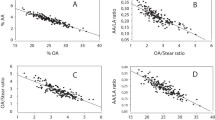Abstract
Arachidonic acid (AA) in the diet can be efficiently absorbed and incorporated into tissue membranes, resulting in an increased production of thromboxane A2 by platelets and increased ex vivo platelet aggregability. Results from previous studies have shown that AA is concentrated in the membrane phospholipids of lean meats. However, the concentration of AA in the visible fat portion of meats also may be significant despite being ignored in most studies. The aim of this study was to accurately quantitate the AA content of visible fat and the lean portion of beef, lamb, pork, chicken, duck, and turkey. The visible fat of meat contained a significant quantity of AA, ranging from 20 to 180 mg/100 g fat, whereas the AA content of the lean portion of meat was lower, ranging from 30 to 99 mg/100 g lean meat. Beef and lamb meats contained lower levels of AA in both the visible fat and lean portion than that from the other species. The highest level of AA in lean meat was in duck (99 mg/100 g), whereas pork fat had the highest concentration for the visible fats (180 mg/100 g). The lean portions of beef and lamb contained the higher levels of n-3 polyunsaturated fatty acids (PUFA) compared with white meats which were high in AA and low in n-3 PUFA. The present data indicate that the visible meat fat can make a contribution to dietary intake of AA, particularly for consumers with high intakes of fat from pork or poultry meat.
Similar content being viewed by others
Abbreviations
- AA:
-
arachidonic acid
- PUFA:
-
polyunsaturated fatty acids
References
Kromhout, D., and de Lezenne Coulander, C. (1984) Diet, Prevalence and 10-year Mortality from Coronary Heart Disease in 871 Middle-Aged Men. The Zutphen Study, Am. J. Epidemiol. 119, 733–741.
Kushi, L.H., Lew, R.A., Stare, F.J., Ellison, C.R., Lozy, M.E., Bourke, G., Daly, L., Graham, I., Hickey, N., Mulcahy, R., and Kevaney, J. (1985) Diet and 20-year Mortality from Coronary Heart Disease. The Ireland-Boston Diet-Heart Study, N. Engl. J. Med. 312, 811–818.
Mensink, R.P., and Katan, M.B. (1992) Effect of Dietary Fatty Acids on Serum Lipids and Lipoproteins. A Meta-Analysis of Trials, Arterioscler. Thromb. 12, 911–919.
Janes, P., Norum, K., and Rosenberg, I. (1992) The Nutritional Role of Fat. Meeting Summary, Nutr. Rev. 50, 68–70.
Leaf, D.A., and Weber, P.C. (1988) Cardiovascular Effects of n-3 Fatty Acids, N. Engl. J. Med. 318, 549–557.
Ferretti, A., Nelson, G.J., Schmidt, P.C., Kelley, D.S., Bartolini, G., and Flanagan, P. (1997) Increased Dietary Arachidonic Acid Enhances the Synthesis of Vasoactive Eicosanoids in Humans, Lipids 32, 435–439.
Nelson, G.J., Schmidt, P.C., Bartolini, G., Kelley, D.S., and Kyle, D. (1997) The Effect of Dietary Arachidonic Acid on Platelet Function, Platelet Fatty Acid Composition, and Blood Coagulation in Humans, Lipids 32, 421–425.
Mann, N., Sinclair, A., Pille, M., Johnson, L., Warrick, G., Reder, E., and Lorenz, R. (1997) The Effect of Short-Term Diet Rich in Fish, Red Meat, or White Meat on Thromboxane and Prostacyclin Synthesis in Humans, Lipids 32, 635–644.
Mann, N.J., Johnson, L.G., Warrick, G.E., and Sinclair, A.J. (1995) The Arachidonic Acid Content of the Australian Diet Is Lower Than Previously Estimated, J. Nutr. 125, 2528–2535.
Sinclair, A.J., Slattery, W.J., and O'Dea, K. (1982) The Analyses of Polyunsaturated Fatty Acids in Meat by Capillary Gas—Liquid Chromatography, J. Sci. Food Agric. 33, 771–776.
Sinclair, A.J., and O'Dea, K. (1987) The Lipid Levels and Fatty Acid Composition of the Lean Portions of Australian Beef and Lamb, Food Technol. Australia 35, 228–231.
Body, D.R. (1988) The Lipid Composition of Adipose Tissue, Prog. Lipid Res. 27, 39–60.
Sinclair, A.J., Johnson, L., O'Dea, K., and Holman, R.T. (1994) Diets Rich in Beef Increase Arachidonic Acid and Long-Chain Omega-3 Polyunsaturated Fatty Acid Levels in Plasma Phospholipids, Lipids 29, 337–343.
Author information
Authors and Affiliations
Corresponding author
About this article
Cite this article
Li, D., Ng, A., Mann, N.J. et al. Contribution of meat fat to dietary arachidonic acid. Lipids 33, 437–440 (1998). https://doi.org/10.1007/s11745-998-0225-7
Received:
Revised:
Accepted:
Issue Date:
DOI: https://doi.org/10.1007/s11745-998-0225-7




